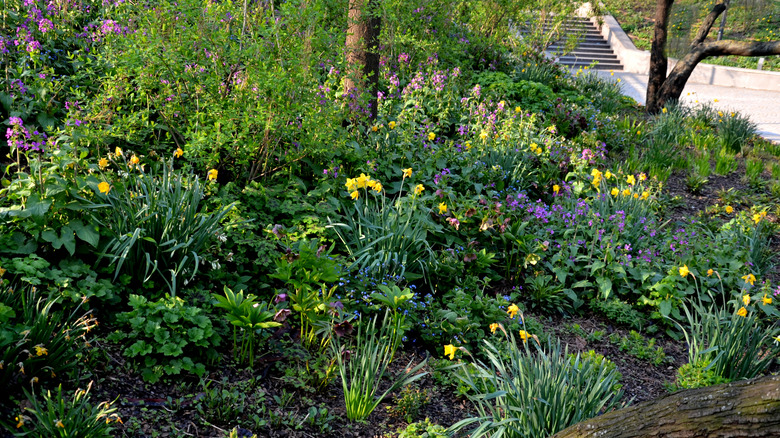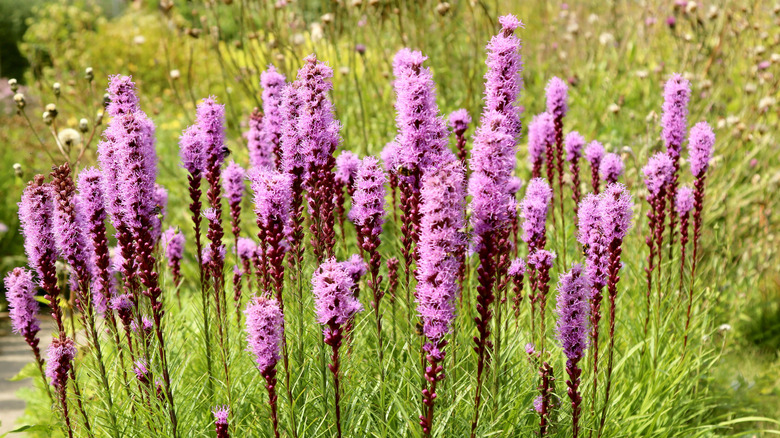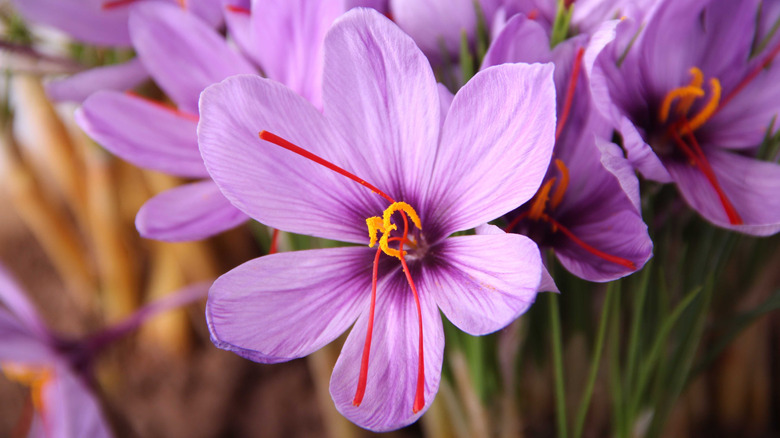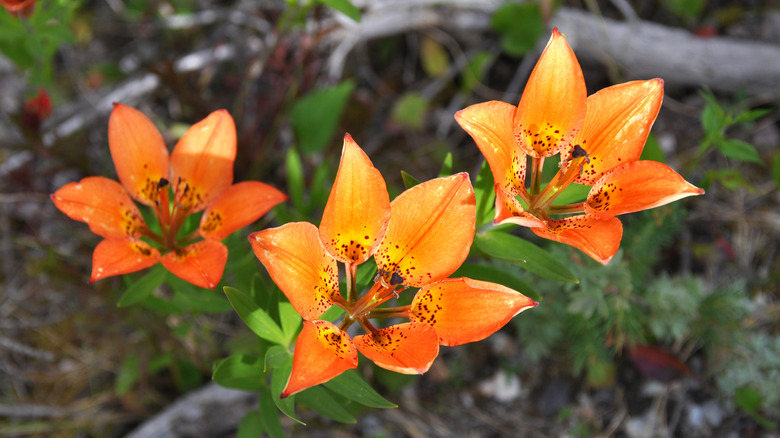The Flowering Ground Cover That Adds More Color To Your Spring Garden
If you want to create a beautiful spring garden, including a variety of interesting textures and eye-catching colors is key. A popular choice that accomplishes both feats is brunnera, which has heart-shaped leaves and cute, blue flowers. But the slow-growing ground cover looks even better when you mix in some flowering bulbs to add splashes of color between the silvery or blue green brunnera foliage.
While there are tons of flowers to choose from that would grow well alongside brunnera (Brunnera macrophylla 'Jack Frost'), it pairs especially well with bulbs. That's because the clump-forming perennial can conceal the dormant foliage of your flowering bulbs once they start dying back. You'll get all the cheerful color of the blooms, without feeling the urge to cut back the yellowing foliage too early, which risks interrupting the bulb's process of storing nutrients and setting new buds for the next season.
So, if you're looking for some bursts of color to liven up your brunnera ground cover, opt for flowering bulbs with striking blooms that can stand out against the plant's silvery blue foliage. Each of the bulbs recommended below will thrive in similar conditions as brunnera, though the best choice depends on exactly where your ground cover is growing. For sunny or part-shaded patches, consider blazing star or saffron crocus. For a shadier brunnera patch, try flame lilies or Jack in the pulpit.
Blazing star incorporates a welcome touch of purple
Blazing star (Liatris spicata) has tall spikes of fluffy lavender flowers that are pollinator magnets. There are many beautiful varieties of blazing star that hummingbirds love. It's also popular among bees, butterflies, and other pollinators, while goldfinches and other birds happily feast on the seeds later in the season. The striking blooms are also lovely additions to cut floral arrangements.
Even after the blooms fade from lavender to tan, they maintain their fluffy texture so you can leave them standing to add visual interest to your garden in fall and winter. Leaving the dormant flower stalks standing also allows birds to forage the seeds hiding inside the flower heads.
This versatile U.S. native can thrive in a range of soil types, from clay-heavy to sandy and tolerates both dry and wet soils. It also tolerates hot summers and is cold hardy in USDA hardiness zones 3 through 8. As adaptable as it is, it does prefer moist, well-drained soil in full sun, so look to plant at a spot in your garden that fits the bill. Otherwise, plunk the bulbs in any sunny (or part shade) area of your yard in spring and you'll be able to enjoy the dramatic blooms that same growing season.
Saffron crocus, the edible option
Saffron crocus (Crocus sativus) is a low-growing and cheery addition to your garden. The thin, grass-like leaves grow to a height of 4 to 10 inches, creating a nice contrasting texture to the large, rounded foliage of brunnera when planted along the edge. If your winters are warm enough, that saffron crocus foliage will persist through to the next spring. But its best feature is the beautiful lavender bloom that appears later in the season.
Once it blooms, the two or three bright red stigmas growing from the center of the flower can be harvested (carefully with tweezers) to use fresh or dried as a spice. The subtle earthy, floral taste adds an intriguing layer of flavor to rice dishes like risotto or paella as well as creamy sauces and desserts.
Hardy in USDA zones 5 through 8, saffron crocus will grow best in the drier, sunnier parts of your yard. Plant the corms in the fall to see them sprout the following spring. They won't need much care after planting. But as they multiply each year, you can dig them up while dormant to divide the corms to prevent overcrowding. Replant the divided corms at about 4 inches apart and use any extras to establish new saffron crocus beds somewhere else.
Flame lilies offer a bright contrast
Flame lilies (Lilium philadelphicum) are a U.S. native with large, vibrant blooms that will have no trouble standing out against brunnera foliage. The flower gets its name from the red or orange petals that typically have a splash of yellow at the base, giving them a flame-like appearance. The stalks carrying these bold flowers can grow up to 4 feet tall. So, you can mix these in among your brunnera or plant a row of them behind so the flame-like flowers can float above the lush, leafy ground cover. While flame lilies are colorful enough on their own, you'll get even more color in your garden as these flowers attract hummingbirds and other pollinators. It's a favorite of various bees and butterflies, including monarch, swallowtail, and fritillary.
The bulbs can be planted in early spring or fall, just be sure to put them somewhere that gets plenty of sun. Flame lilies tolerate partial shade and even full shade, but the more sun it gets, the better it blooms. It prefers drier, sandier soils as the bulbs are prone to rot if the soil is too wet. The plant is cold-hardy in zones 4 through 7.
Jack in the pulpit brings woodland charm
For a striking addition to the garden that will complement the dramatic foliage of brunnera, add Jack in the pulpit (Arisaema triphyllum). It's one of the few spring bulbs that can give you three seasons of interest. In spring, this woodland flower produces green and purple-striped tubular blooms with a hood. These unique flowers will last until about June or July. At that point, the flowers are replaced by clusters of glossy green berries. Come fall, those berries turn bright red.
Jack in the pulpit is also a great choice for gardeners who need something deer resistant. All parts of the plant contain calcium oxalate crystals, which makes it unpleasant for wildlife to consume. Just make sure to wear gloves when handling as that same compound can irritate your skin on contact. For the same reason, if you have children or pets that play outside, you might want to skip this plant or keep it somewhere that they can't get to.
Native throughout the eastern half of the United States, Jack in the pulpit can thrive in USDA hardiness zones 4 through 8. The woodland plant is adaptable to a variety of soil conditions but prefers moist, well-drained soil with plenty of organic matter. It also prefers partial to full shade. While it doesn't need much care once planted, covering it with leaves after it goes dormant in fall and leaving them through the winter will preserve moisture and add organic matter.




